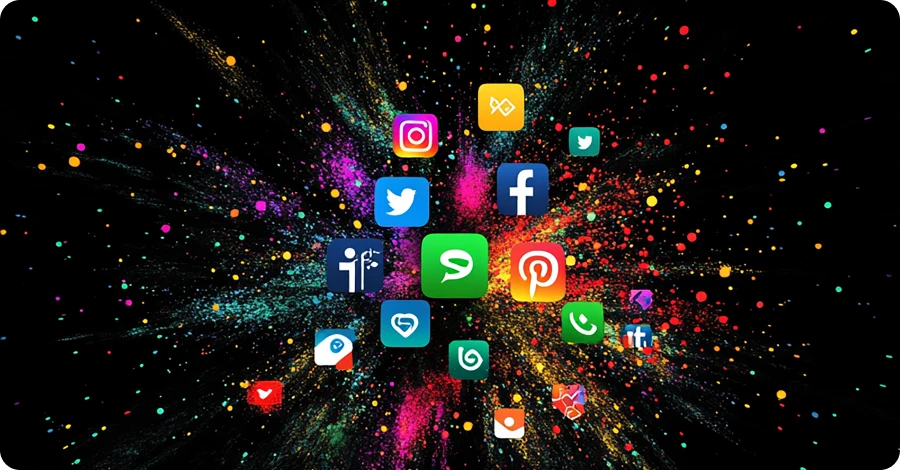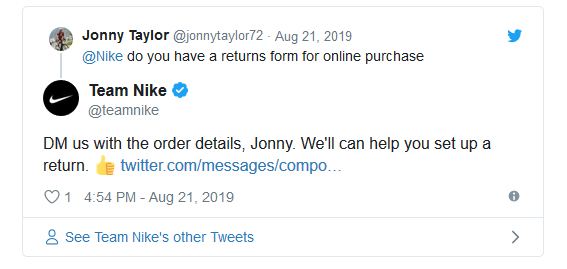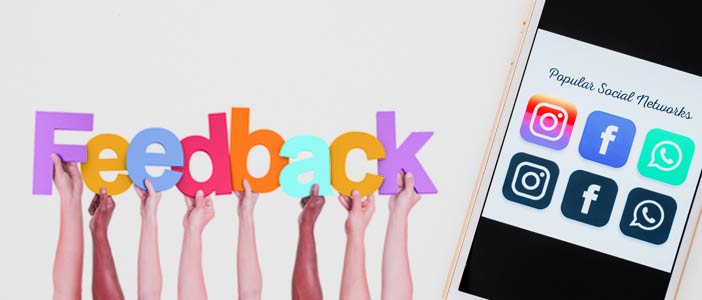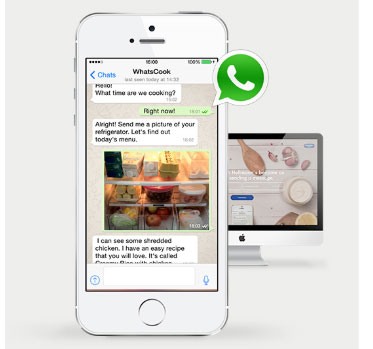How to Use Social Media for Business with Examples (2025)
- June 15, 2016
- 40 mins read
- Listen

Table of Content
The impact of social media on business, both positive and negative, is immense. Do you agree? 90% of businesses agree with this.
Whether you are a startup or a small business, an online store or an enterprise, social media is vital for your business marketing strategy. According to a recent survey, 71% of consumers who have had a good social media service experience with a brand are likely to recommend it to others. It shows the importance of social media for businesses. To maintain a competitive pace, businesses are bound to leverage popular social media platforms.
Social platforms help you connect with your customers, boost brand awareness, and increase your leads and sales. With close to five billion people across the globe using social media, it’s no passing trend. Social media is far more than just a digital advertisement for your brand—it’s a powerful tool for connecting directly with your ideal audience and gaining meaningful insights. From customer service to market research and better engagement, social media influences every aspect of your business.
What is Social Media for Business?
In simple terms, social media channels for business refer to the usage of various social platforms, such as Facebook, Instagram, LinkedIn, and Telegram, to promote a brand, build relationships with customers, and drive business growth.
In 2023, global social media usage is set to reach a record 4.9 billion users. By 2027, experts forecast this number will rise further to 5.85 billion. So, it is evident that social media is redefining how businesses execute their marketing strategies. It enables brands to use different platforms for promoting products or services, engaging content and even offering excellent customer service to achieve key marketing objectives and better customer engagements.
The positive impact of social media on business is huge. How can social media help a business grow? The answer is social media marketing. It gives companies great opportunities to engage with their consumers, reach a global audience, and foster brand loyalty. It goes beyond just building brand awareness. It is capable of directly impacting customer relationships, revenue generation, and overall business success. To stay competitive in today’s digital age, you have to get a handle on social media marketing and continuously adapt new strategies to keep up with the rapidly changing market.
Benefits of Social Media for Business
Social media has greatly transformed the business landscape. It is one of the most important aspects of digital marketing, which provides incredible benefits that help reach millions of customers worldwide.
If you are a CEO or a small business owner, it is very important to know why you need to be on social media and how it is going to affect your business.
There are several questions you must ask yourself before you plan your social media strategy
- What are the channels where my customers are present?
- What are the ways to target my audience on those channels?
- What are my objectives and the RoI of the social media strategy?
So, it is evident how social media can have an immense impact on your business and can be one of the most powerful marketing channels to reach out to your audience.
In a nutshell, social media for businesses has benefited in three key areas.
- Brand Building
Social media is one of the most profitable digital marketing platforms that boosts your brand’s visibility among potential customers, allowing you to reach a larger audience. By applying a social media customer service strategy, you significantly increase your brand’s recognition.
- Omni-Channel Engagement
Research shows that 60% of US millennials expect consistent experiences when dealing with brands online, in-store, or by phone. Social media strategies boost user engagement across channels in order to engage customers and deliver a better omnichannel customer experience.
- More Lead Generation
While companies recognize the value of social media for building brand awareness, what they often don’t understand is that it’s also a powerful tool for generating leads, both directly and indirectly. So, make sure your social media platforms are optimized for easy conversions. With passing time, these social media platforms have become more effective at driving leads, with many integrating clear calls-to-action (CTAs) into brand pages and posts.
Platforms like Facebook, Instagram, and Snapchat have introduced updates emphasizing CTAs, enabling businesses to showcase their products and services in a better way. This has made in-platform sales more common than ever. Additionally, many platforms now include extra CTAs on profile landing pages, going beyond the traditional ‘Follow’ and ‘Message’ buttons to improve conversion opportunities.
- Content Promotion
Want to humanize your brand? Start promoting high-quality content. When you share valuable content with the right audience, it sets your brand apart from the rest that don’t or miss the mark.
Think of social media as your own publishing platform. Utilize channels like Facebook, X (formerly Twitter), YouTube, and Instagram to share articles, blogs, and videos for driving traffic to your website or blog. When you have worked so hard to create content that informs or entertains your target audience, use social media to make sure it gets seen.
- Better Organic Visibility
It’s important to understand how social media marketing impacts SEO as well.
Google has made it clear that social media likes, shares, and backlinks are not direct factors that help in rankings but there is a connection between social media activity and search engine rankings. Though your social media shares do not act as full-value backlinks, the exposure your content receives can lead to valuable links. When people and other brands discover your high-quality content through social media, they may link those with their own content, and those backlinks contribute real value to your SEO efforts.
- Improved Website Traffic
Social media has a positive impact on a brand’s website and, if applicable, its physical store as well. Social media channels help brands engage different audiences in a relatable, informative, and entertaining way and attract potential customers who might not have otherwise discovered your business.
If executed properly, this strategy is effective across all platforms. Social media also acts as a bridge, directing both new and existing customers to your website or physical store or even both, if their journey is well-mapped out.
For instance, if you are promoting a new product on Instagram, direct followers to your website by including a link in the post. On your website, offer an in-depth exploration of the product with detailed information, images, videos, and links, helping customers fully understand and make the buying decision easily.
How to Set Social Media Goals for Your Business?
First, let’s understand what social media goals are. Here’s one definition to look into:
A social media goal is a target you aim to reach through your social media marketing strategies. These goals should directly support your overall business objectives.
Setting clear and effective social media goals is easier than you might think. Here’s a step-by-step guide to help you define and achieve smart social media objectives.
1. Set Your Business Objectives
Before you start brainstorming for new ideas, first, think: what challenges does our business need to solve? Or, what would bring the most value in the next year?
Maybe the answer is, “We need more happy customers,” or “We need more and more website traffic.”
Always keep this in mind: your social media goals should align with your business objectives. For instance, if your target audience often compares you with another competitor offering the same product segments, use your social media presence to showcase your uniqueness and build your brand’s identity. Make sure your business goals drive your social media strategy.
2. Use the SMART Concept to Evaluate Your Objectives
Once you have outlined your business objectives based on current social media marketing trends, it’s time to evaluate how realistic those goals are. You can use the SMART framework to check if your goals are achievable or not.
The concept SMART criteria shows:
- Specific: Clearly define what you want to achieve
- Measurable: Make sure you can track your progress using metrics
- Achievable: Set goals that are possible to achieve with the help of other resources
- Relevant: Ensure your goals align with your broader business objectives
- Time-bound: Set deadlines to maintain focus and momentum
3. Set KPIs to Measure the Outcomes
Once you’ve established your business goals, the next step is to measure the outcomes. To do this, you’ll need key metrics and performance indicators (KPIs) that track overall results. For example, if your goal is to boost website traffic by driving visitors from social media, you should focus on KPIs related to website traffic.
Some of the common metrics to consider:
- Engagement: Likes, shares, comments, and mentions on your social media channels.
- Reach: The number of people who see your posts.
- Referral Traffic: Measure the number of visitors coming from social media platforms to your website.
- Click-through rate (CTR): Track the percentage of users who click on your social media posts or ads and are directed to your website.
- Bounce Rate: Monitor the percentage of visitors who leave your website after viewing only one page. It helps to understand how engaging your landing pages are.
4. Plan Your Strategies
Once you have successfully set your goals and success indicators, it’s time to plan your path to achieve them. Start by brainstorming strategies that will help you reach those business objectives. For social media marketing, that might involve:
- Scheduling posts regularly to increase your brand visibility
- Engaging with your audience through comments and likes to build relationships
- Creating attractive content that appeals to your target audience
- Test different content types and social platforms to see what works best
- Planning and scheduling your posts in advance
- Focusing on those social media platforms where your audience is most active
- Investing in social media ads to reach a broader audience
5. Monitor and Optimize
Once you have launched all your social media strategies on work, the final step is to monitor the progress using the metrics and KPIs we have set before. This allows you to see if all your efforts are on track to meet your goals. You can further make necessary adjustments if required to get the best results. Regularly evaluating and optimizing your approach helps you to move forward toward your objectives.
How to Use Social Media to Grow Your Business?
Social media impacts businesses positively and offers an opportunity for your audience to find you on social media. It helps you reach your targeted audience, stay engaged with them, and respond to their queries instantly. It is a great way to evaluate your competition by monitoring their social media pages.
The impact of social media on global business is huge in terms of brand recognition, customer engagement, revenue, and customer service. It is also a great tool to evaluate your competitors and how they are using social media for their growth.
Here are 9 ways you can use social media to grow your business:
1. Social Media Adds a New Dimension to Your Omnichannel Customer Service
Today’s customers choose social media as the main source to interact with a brand because they get instant attention. Research says that 42% of consumers expect a response on social media within 60 minutes.
Social media is a powerful channel to engage customers who reach out to you through different social media channels such as Facebook, Twitter, LinkedIn, Instagram, and Whatsapp to deliver a seamless omni-channel messaging experience.

Providing omnichannel customer service is an important aspect of a business. However, it is even more important to use the right tools, and systems that can help your business deliver an omnichannel experience across the customer lifecycle.
In order to deliver omnichannel customer service, you can use certain tools. One such tool is REVE Chat, which is a multi-channel live chat platform that streamlines customer conversations across website, social, mobile, and messaging apps to deliver great customer service and increase team productivity.
Sign up with REVE Chat today! Engage your customers across their preferred social channels and respond to their messages and comments instantly.
Nike followed an excellent customer service strategy. It has one of the strongest customer service accounts on Twitter. They feature a dedicated Twitter account, Team Nike, which provides support seven days a week and in seven languages.

When a customer mentions Nike’s main Twitter handle, @teamnike responds instantly. This shows how dedicated the brand is to solving its customers’ problems.
Best Practices:
- Pay attention to all customer service issues and be kind to them in all scenarios. Passive complaints that are left unaddressed can easily cause a rift between the vendor and the customer.
- Manage your social conversations promptly in order to deliver superior customer service.
- Enhance your customer experience by being available across all the touchpoints that customers prefer to contact you to deliver instant support.
2. Social Media Helps to Reach a Bigger Audience
A report by Search Logistics, 90% of marketers say their social marketing efforts have increased exposure for their business, and 75% say they’ve increased traffic. It is an ideal way to create brand awareness and stay in contact with your customers.
Social media platforms are becoming the main source for people to learn more about businesses – the latest information about new products, services, advertisements, deals, or promotions.
Here are some tips to expose your brand to a broader audience.
- Segment Your Audience – Prior to heading up to the social platforms, make sure that your target audience is on the platform or not. It’s not at all wise to blindly follow other brands.
- Make Use of Visuals – Once you have segmented your audience, make use of attractive visuals along with content to grab immediate attention and boost engagement.
- Initiate Conversations – Involve yourself in the social platforms not only by listening but also by building great conversations by tagging or mentioning others.
- Measure Your Efforts – It is very important to measure your social activity by using external tools. Gain insights, channel your efforts, and strengthen your brand image.
The social channels allow the sharing of business news and even posting related photos or links to stories/studies in their industry. It also builds trust with its customers and showcases itself to a new demographic of potential clients. You can also use them to add value to your guerrilla marketing examples in a subtle way.
Best Practices:
- Identify your target audience, their patterns, and behaviors, and then choose the right social media channels for your business.
- Social media is a place to forge connections and give your brand a voice. Ensure that your tone is consistent and friendly and suits the business that you are trying to showcase.
- Visual and engaging content is key. To publish relevant, quality content and involve your audience, ask questions, use polls, and host events.
3. Social Media Creates Word of Mouth
Social media feeds for businesses help get the word out about your business. With the arrival of interactive and social media, the patterns, roles, and impact of word of mouth have evolved. Due to this, new online communities are forming.
Such changes affected the ways businesses can leverage the power of word of mouth for marketing purposes and, vice versa, the impact of word of mouth on businesses. As per Qualtrics, 72% of people see online reviews in the same light as personal recommendations made by friends and family.
Great Word-of-Mouth Marketing Example – Threadless
Threadless is an online community of T-shirt designers and a platform where they can submit and vote on T-shirt designs. The designers were paid 20% in royalties and either Threadless gift cards or cash.

The members were happy to promote their designs and bring more people to the site through good word of mouth.
Best Practice:
- Offer an incentive such as a discount, a free product, or an extended service to your customers so that they take the time to promote your business.
4. Social Media Marketing (SMM) is Economical
Many businesses are jumping on the Social Media Marketing (SMM) bandwagon as it has a positive impact on brands and promises profitable success when done properly. Social media marketing techniques target social networks and applications to spread brand awareness.
Social media marketing is perceived as a more targeted type of advertising, and therefore, it is very effective in creating brand awareness. Social media engagement campaigns produce a lot of shares, generate more views, and generate publicity for your business – all for a one-time cost.
Social media marketing campaigns usually center around:
- Establishing a social media presence on major platforms
- Creating shareable content and advertorials
- Cultivating customer feedback throughout the campaign through surveys and contests
A single person sharing or re-tweeting a message from your company could reach hundreds or even thousands of people for virtually no cost! Businesses that miss out on this with social media strategies that don’t generate engagement are losing a major opportunity.
Best Practice:
- If you are a startup or small business, use social media marketing to promote your business and save money.
5. Social Media Allows Collecting First-Hand Customer Feedback
Social media is a potent ingredient of the customer feedback cocktail.
Social media platforms allow for collecting first-hand feedback from customers to improve the brand’s image, reputation, and relationship with them. The customer must feel like they are heard and valued, and this makes them happy.
So, respond to every post, comment, and suggestion and make the best use of them for your brand’s development. Businesses that engage with customer service requests via social media earn 20% – 40% more revenue per customer.

This will allow you to showcase just how much you care about providing a memorable experience and will ensure that no customer feedback goes unnoticed. By monitoring social media for customer feedback and offering a response, you can drive real business results.
Best practices:
- Respond even if the user has not directly tweeted at you or asked for help. When you answer brand mentions or comments it shows you are paying attention.
- Promote your customers by retweeting a happily resolved support interaction. It is like giving your customers a big thank you.
- Give your customer service team a public face. Use a team photo or an agent spotlight. It’s nice to connect the face of the brand with the name behind it.
- Try to follow up a resolved interaction with, “How is everything?”
6. Social Media Improves User Engagement
No matter whether businesses are on social media or not, customers follow their social media accounts every day. With the average person spending just under two hours per day on social media, social media engagement is essential to make sure your brand is capturing enough attention.
Setting up a social media presence and building and engaging it effectively with quality content is a big effort. However, the biggest benefit you can glean from your investment in social media is to reach out to your potential customers wherever they can be found across the globe.

Social media engagement is positive because of the reputation it generates for your brand but on the other hand, a single negative tweet can bring bad publicity overnight, which is difficult to reverse. Below are a few best practices for engaging users.
Best Practices:
- Keep your brand at the top of the newsfeed by posting witty and engaging content regularly.
- Images increase interaction rates so use images.
- Try being personal with your audience. Make them feel there are real people behind the brand.
7. Social Customer Service is the New Marketing
Providing stellar customer service is likely already a top priority for every business. But along with the two-way communication that social media provides, it also offers a unique opportunity to step up your customer service game and provide instant gratification to your target audience.
WhatsApp, for example, is the most popular channel for customer service on a global scale. The numbers say there are more than 1.5 billion monthly active users sharing more than 60 billion messages every day, a huge amount of on-platform activity.
WhatsApp Business app, launched by WhatsApp, enables business users to “interact with customers easily by using tools to automate, sort, and quickly respond to the messages”.
Hellmen is one of the best examples to show the impact of social media on business. Hellman wanted more Brazilians to cook with their mayonnaise, and they thought of an interesting campaign using WhatsApp.

The campaign had the option to connect with a chef through WhatsApp. Once connected with the chef, they only had to click a picture of their fridge and share. Now, the chef would plan a recipe out of it and cook the meal together, staying connected through WhatsApp.
Best Practice:
- You should be prompt in responding to online reviews. Customers share their positive and negative feedback over social media. Respond to your social media comments quickly. Otherwise, it will affect your brand image.
8. Social Media Can Be a Driving Force of Growth Tools
The impact of social media in marketing offers opportunities for brands to increase conversions due to the interaction that they have with customers. When a brand chooses a proactive social media marketing approach, it will strengthen its marketing strategy.
Hubspot research social media marketing has a 100% higher lead-to-close rate than outbound marketing. This data proves social media marketing critical for all brands, big or small, and especially those who are trying to increase sales revenue.
Twitter is a good example of this. According to MediaBistro, 67% of Twitter users are more likely to buy from brands that they follow. Besides, 42% of consumers learn about the products and services they are interested in through Twitter. This type of outreach cannot be ignored.
Best Practices:
- Use targeted social media listening to understand what is happening in your industry.
- Get engaged in social selling (social selling combines the elements of social listening, social media lead generation, and sales practices).
#9. Social Media Boosts Your Brand Loyalty
“A brand is nothing but an expression of the customer’s loyalty and trust.”
Building and maintaining brand loyalty is one of the central themes of every business. Social media helps you build relationships with your customers, which increases loyalty and advocacy.
Brand loyalty matters due to the following reasons:
- In this competitive market, brand loyalty is hard to come by. Customers have multiple accessible options that can lose them easily. Perception of your brand builds new customers, but loyal customers add real value.
- Loyal social media followers are more likely to interact with your posts and create meaningful conversations. Real engagement is more valuable to your online image.
- Loyal social media followers are high-potential brand advocates. They’re very likely to talk positively about your brand, even without persuasion.
Developing brand loyalty ensures long-term engagement on social media. Research shows that 66% of users between the ages of 18 and 24 are more loyal to the brands they follow on social media.
Best Practices:
- You should create a smart social media strategy that comprises a cohesive plan to keep up with your competition.
- Share good quality content to inspire brand loyalty. Visual content gets easily noticed. So, use infographics, videos, screenshots, graphs, etc. to make content more appealing.
- Ensure that you are not sidelining interactions as followers, like humanized interactions, not bots or automated content.
How Social Media Impacts Different Business Types & Sizes?
Social media is one of the most valuable mediums for businesses of all types and sizes, offering a powerful way to engage with their target audiences and increase brand awareness. This has enabled even small businesses to build a unique identity and stand out from the big giants. It impacts businesses of all types and sizes differently, offering unique advantages and challenges based on their scale, industry, and objectives. How do various businesses use social media for marketing? Let’s read it out!
1. SMBs
You must be thinking, how does social media marketing affect small businesses? For small business owners with limited resources or those startups who have just started, building a social media presence on the prime channels is a practical marketing strategy. Through platforms like Facebook, Instagram, Telegram or WhatsApp, you can easily promote your products and services while directly connecting with your customers personally. It’s an affordable marketing tool that allows you to reach a large audience with minimal investment.
Even with a small team or if you are handling it solo, you can easily develop, execute, and manage a social media presence that successfully engages your target market.
Benefits of Social Media for Small Businesses:
- Brand Awareness: Social media offers an affordable way for new and small businesses to reach a large market for brand awareness without significant marketing budgets.
- Customer Engagement: Direct interaction with customers is much easier here. Responding to comments, messages, and reviews helps to offer better customer service and customer engagement.
- Localized Targeting: Platforms like Facebook and Instagram offer local targeting features, helping small businesses focus on nearby customers.
2. Enterprise
For enterprise brands, social media is one of the most essential platforms to get success. Here, the brands get access to valuable global customer data, which is crucial to stay ahead in the long run. Social insights also enable easier measurement and attribution of large-scale campaign success, significantly impacting overall business strategy. Additionally, enterprises also use social media to humanize their brand, share their story, and develop an emotional connection with their audience, strengthening customer relationships and enhancing brand loyalty.
Benefits of Social Media for Enterprise
- Global Reach: Social media platforms allow enterprises to extend their reach globally, connecting with millions of potential customers across different regions and demographics.
- Direct Communication: Social media enables big brands to interact with customers directly through comments, messages, and reviews, fostering stronger customer engagement.
- Customer Support: Many enterprises have integrated social media into their customer service strategy. Platforms like Twitter and Facebook are used to offer instant assistance to customers.
- Crisis Management: Social media serves as a critical tool for managing public relations during different crises. Companies can respond quickly to negative news or public criticism, allowing them to control the narrative and mitigate reputational damage.
- Targeted Advertising: Social media platforms provide advanced targeting capabilities that allow enterprises to reach specific demographics and customer segments. Paid advertising on platforms like Facebook, LinkedIn, and Instagram can drive significant traffic and generate qualified leads.
3. Nonprofit
Social media is an essential resource for nonprofits to expand their reach and build support. With huge numbers of users globally, its impact is undeniable. Through social platforms, nonprofits can build brand awareness, communicate their mission, and connect with their target audience. If you can use social media effectively, you can easily broaden the brand reach, boost fundraising efforts, and inspire greater action for social causes.
Benefits of Social Media for Nonprofit Businesses
- Better Brand Visibility: Social media allows nonprofits to reach a larger audience and boost their visibility.
- More Donations: By sharing impactful real-life stories, analytics, and campaigns, nonprofits can motivate their audience to contribute and support their mission.
- Greater volunteerism: Nonprofits can promote jobs and volunteer opportunities, encouraging others to get involved.
- Enhanced storytelling: Visual platforms like Instagram, Facebook, and YouTube enable nonprofits to share compelling photos, videos, and testimonials that emotionally resonate with their audience, making their mission more relatable and engaging.
4. B2B Business
Unlike B2C marketing, which focuses on direct consumer engagement and quick sales, B2B social media marketing is more about social selling, offering valuable content, and positioning the brand as a thought leader. Traditionally, B2B companies have relied on formal, direct marketing strategies, but social media has unlocked new possibilities for networking, generating leads, and strengthening brand presence among their target audience.
Benefits of Social Media for B2B Businesses
- Brand Awareness: B2B companies use social media channels to showcase their expertise and position themselves as industry leaders among their target audience. Sharing insightful content, such as white papers, case studies, and blogs, helps them to build credibility and trust with potential clients.
- Expanded Reach: Social media allows B2B companies to reach a broader audience beyond traditional channels.
- Targeted Ads: Social platforms like LinkedIn, Twitter, and Facebook offer advanced targeting options for B2B companies to focus on specific industries or geographic locations.
- Direct Communication: Social media provides a direct line to customers, enabling B2B companies to build relationships, answer queries, and resolve issues in real time.
- Brand Management: B2B companies can easily monitor and manage their online reputation through social media channels. By tracking mentions, reviews, and conversations, businesses can understand public sentiment and respond quickly to any negative feedback.
5. B2C Businesses
Given the vast number of people who browse social media daily, these platforms offer extensive reach and engagement opportunities for B2C businesses. From crafting relevant content and targeting the right audience to staying current with social media trends, B2C companies can achieve remarkable results through social media.
Benefits of Social Media for B2C Businesses
- Enhanced Brand Visibility: Regular updates, targeted advertisements, and engaging content help B2C businesses expand their reach.
- Targeted Advertising: Platforms like Facebook and Instagram provide advanced targeting options, enabling B2C brands to focus on specific demographics based on customer interests, location, and behavior.
- Cost-Effective Marketing: Social media marketing is generally more affordable than traditional advertising methods. B2C companies can execute targeted campaigns within their budget, monitor performance in real time, and adjust strategies as needed.
- Creative Content Sharing: Social media is perfect for distributing diverse content, such as videos, images, blog posts, and promotions, boosting customer engagement and visibility.
- Competitive Analysis: Businesses to track competitors’ activities, gain insights into their strategies, and identify emerging market trends.
Negative Impact of Social Media on Business
Everything has its positives and negatives, and social media is no exception. So far, we’ve explored the positive impacts of social media marketing. Now, let’s look at its drawbacks. Recognizing these challenges will help you tailor your business strategies more effectively.
1. Time-Consuming
To manage multiple social media platforms, you need to work on regular content creation, posting, and monitoring, which can be time-consuming for businesses, especially small ones with limited resources.
2. Misinformation
Another negative aspect of social media is the dissemination of misinformation. With the rapid sharing of information, misleading content can easily circulate, which can lead to confusion, rumors, and negative impacts on public opinion and behavior.
3. Fast-Paced Environment
Social media trends, tools, and best practices tend to change rapidly. Businesses must continuously adapt their strategies to keep up, which requires time and resources.
4. Security and Privacy Concerns
A major downside of social media comes with the privacy and security risks. Personal information that we share on these platforms can be easily misused if we don’t follow proper security measures. Key risks include unauthorized access to sensitive data and potential data breaches, posing significant threats to user privacy.
5. Brand Vulnerability
Social media increases a company’s exposure to the outer world. Any missteps, such as controversial posts or improper responses, can be damaging to the brand’s reputation.
6. Online Harassment
Many times, brands get targeted by internet trolls, leading to negative or inappropriate comments that may affect customer perception.
8 Best Practices of Social Media for Business
Statista reports that 61.4% of the global population, about 4.95 billion people, use social media. So, why is social media important for your business? If you want your brand to stand strong in the highly competitive market, it’s essential to connect with this large audience.
A well-crafted social media marketing strategy that incorporates proven social media best practices is an effective way to boost your brand’s visibility. It will also help you to promote your products and services cost-effectively. Sounds confusing? Here, we have listed down 8 best practices for social media strategy that can simplify the process and help you to achieve the best results.
1. Monitor Your Competitors’ Activities
To refine your social media strategy and use it in the best possible way, you need to understand whether your social media presence is better than your competitors or not. Look at their posts regularly and try to understand:
- What seems to be resonating well with their audience, and what isn’t?
- What kinds of content are they posting?
- How often and when are they sharing posts?
- Are they working with influencers to boost brand visibility?
- Which demographics are they focusing on?
- How much are they spending on social media ads?
Answering these questions will help you understand how to improve your own social media efforts and increase your brand’s effectiveness on these platforms.
2. Check on Your Social Media Customer Service
As more people seek customer support through social media, you need to recheck whether you are offering good customer service over that social media channel or not. Remember one thing: for your consumers, it’s important to offer quick responses to their queries.
So, reevaluate your approach to social customer care as a top priority. You can enhance your social customer care efforts by leveraging appropriate tools, including AI and automation tools like REVE Chatbot, which offer automated real-time assistance to your customers, bridging the gap between social media and customer service.
3. Evaluate the Social Media Preferences of Your Customers
Understanding what your customers want and prefer is always important to shape your social media strategies. Social media platforms offer extensive customer data, which can guide your business decisions and marketing strategies.
In addition to generic geographical information, ask these questions to yourself while gathering customer data for your social media campaigns:
- Which social media platforms are most popular among your target audience?
- How familiar is your target audience with your brand?
- What values are important to your customers?
Understanding these aspects allows you to reshape the sales funnel and change how customers perceive your brand.
4. Utilize Your Employees’ Strengths
Your employees are some of your strongest brand advocates. They need to be happy and satisfied working with your brand. Integrating their positive thinking regarding your product offerings into your social media strategy is a highly effective way to create trust, boost your content’s reach, humanize your brand, and engage with your audience. With employee advocacy programs and a consistent flow of content, you can set the foundation for long-term success.
5. Social Commerce Optimization
Social media channels give you a huge set of data to understand customer preferences. Based on this info, you need to build up a clear strategy on where your customers prefer to shop the most.
You can sell your products or services directly on those social media channels and may link back to your website. But you need to optimize these channels for social commerce to eliminate the gap between your customers and products. You should use some of the all-in-one social commerce tools to ease the process for both your company and the customers. For example, REVE Chat’s customer engagement solution can help you seamlessly integrate your social and commerce workflows.
6. Ensure Consistent Brand Identity Across All Channels
Define what message your brand wants to convey. Many brands struggle hard to maintain this consistency across their social media channels. A consistent brand message helps your brand to stand out from competitors and stay aligned with its core values.
How do we maintain such consistency? Here are some of the key pointers to look into:
- Standardized spelling, capitalization, and use of key brand terms
- Consistent use of hashtags and slogans, especially those featuring your brand’s name
- Visual style and overall tone
- Proper guidelines for sharing valuable resources
- A content approval process and posting schedule
- A clear and predefined process for responding to comments
7. Quality Content Over Quantity
Less can often be more! Just like you prepare valuable content for your website, focus on producing high-quality social media content as well that delivers real value to your target audience. Rather than posting generic content every day, aim to share engaging and impactful posts every alternate day on your social channels.
Keep updating your social pages with relevant and timely content. You can create an editorial calendar to organize and schedule your social media postings. At the end of that period, review the calendar and adjust it based on the content that received the most engagement.
8. Ensure Social Media Security and Privacy
Most of the businesses rely on social media for marketing and customer engagement. So ensuring the security and privacy of these accounts has become more important than ever. A single breach may lead to compromised customer and official data, reputational harm, and loss of trust. By implementing smart security measures and privacy safeguards, you can protect your social media presence from potential threats and keep your business and customers safe.
Here are some tips for you!
- Add an extra layer of security to your accounts by enabling 2FA, which requires both a password and a second authentication method, like a code sent to your phone.
- Ensure that all social media accounts use strong, unique passwords.
- Grant account access only to trusted team members.
- Regularly monitor account activity for any suspicious behavior.
- Only connect trusted third-party apps to your social media accounts.
Top 5 Social Media Marketing Examples
Social media has become more important than ever for brands aiming to attract new customers, broaden their reach, and grow their audience. But achieving success goes beyond just posting content. Brands need a powerful social media engagement strategy that includes creative content, targeted messaging, and effective advertising.
That’s where we can assist. We have compiled 5 examples from brands that showcase how they effectively use social media to achieve the best results.
1. Airbnb’s User-Generated Content Strategy
Airbnb has expertly utilized user-generated content (UGC) to craft engaging social media campaigns for their target audience. By encouraging travelers and hosts to share their experiences and tag Airbnb in their posts, the company has built a large, active community on Instagram.
Others have also started following the concept by uploading authentic photos showcasing their stunning getaways. As a result, Airbnb has strengthened its brand credibility and fostered trust, motivating others to use the platform to explore new destinations. Their approach to user-generated content (UGC) has proven highly effective in increasing bookings and strengthening customer loyalty.
2. Dove’s Campaign #ShowUs
Dove is a personal care brand that has established itself as a leader in the beauty and personal care industry.
To showcase the diversity of beauty, Dove launched Project #ShowUs, a campaign aimed at challenging conventional beauty standards. In partnership with Getty Images and Girlgaze Photographers, Dove developed the world’s largest stock photo library curated by women, featuring images of female-identifying and non-binary individuals.
Dove has featured over 5,000 photographs of women from across the globe. The library was introduced via social media, with Dove creating video content for YouTube and partnering with influencers to amplify the message. This strategic approach effectively connected with Dove’s target audience, celebrating individuality and encouraging self-acceptance on a global scale.
3. Nike’s Bold Move in Social Activism
Nike’s ‘Dream Crazy’ campaign, which features former NFL player Colin Kaepernick, serves as a standout example of purposeful social media marketing. By addressing a contentious social issue, Nike generated considerable debate online. Despite the mixed feedback, the campaign led to a significant boost in brand mentions, engagement, and online sales. This shows that when marketing strategies align with a brand’s core values and support causes that resonate with its audience, they can be highly successful.
4. Apple’s Campaign for Enhanced Learning Process
In 2023, Apple tapped into the popular ‘Study With Me’ trend with a 90-minute video featuring actress and college junior Storm Reid. In the video, Reid uses the Pomodoro Technique – 25-minute study intervals followed by 5-minute breaks – to illustrate a productive study routine.
This campaign is part of Apple’s broader initiative to connect with students and demonstrate how its products, like iPads and MacBooks, can enhance learning. The videos highlight students using Apple devices to boost productivity and focus during study sessions. By adopting a trending format, Apple effectively reached its target audience through impactful social media marketing.
5. AllBirds’ Buzz-Worthy Product Launch
Allbirds is an eco-conscious footwear and apparel company that creates high-quality, comfortable shoes using sustainable materials. They had a well-executed campaign to launch their new sneakers on social media channels.
They ran a buzz-generating campaign across Instagram and YouTube that got people excited and eager to purchase their footwear even before the official release. Allbirds started by showcasing high-quality images of its sneakers to tease its audience. On YouTube, they produced a witty introduction video that highlighted their eco-friendly mission. They also partnered with affiliates to generate content across social media and other marketing platforms, which helped spread the word and drive growth.
5 Most Popular Social Media Marketing Platforms for Business
With so many social media platforms available, finding the right one for your marketing campaigns and audience engagement can make you feel a bit confused. But don’t worry—we’re here to help! While the perfect platform for your business may take some time to identify, we have narrowed down the top five social media channels you should consider. Let’s read to know more!
1. Facebook
With over 3 billion active monthly users, Facebook stands out as one of the top choices for social media marketing. People across various age groups use it to connect with their friends and family, join groups and forums, discover local businesses, and follow their favorite brands.
Facebook supports a wide range of content formats, including photos, videos, GIFs, and Stories, giving a chance to the brands for showing off their product offerings. However, the key to effective Facebook marketing lies in creating content that encourages conversations. Facebook’s algorithm favors unique and engaging content, so be sure to craft your content strategy with that in mind!
Facebook is a good social media marketing platform to:
- Reach a broad audience
- Build brand awareness
- Promote products and services
- Drive website traffic
- Announce product launches or big events
- Run different activities like polls or quizzes for better customer engagement
- Improve community engagement, etc.
2. Instagram
Instagram is a great platform for businesses and marketers who are new to social media marketing. From teens to millennials and beyond. Instagram attracts a wide range of audience. With various content options such as photos, videos, Reels, Stories, and more, getting started for your business on this platform is very simple.
Instagram simplifies content sharing for your audience, and the more your content gets shared, the faster your brand gains visibility, helping you stay ahead of competitors. With photos and videos dominating internet traffic, Instagram offers a widely popular platform to showcase your brand to a global audience.
Instagram is a good social media marketing platform to:
- Social shopping
- Influencer marketing
- Increase brand visibility
- Drive website traffic
- Create and share engaging visual stories
- Run targeted ads, etc.
3. Twitter
Twitter is an ideal platform for businesses that frequently publish original content. It allows users to easily share links to their new blog posts or webpages, and by doing so consistently, you can drive traffic directly to your latest content. Many people turn to Twitter for the latest news, to follow brands they like, and to seek customer support. Be sure to retweet positive feedback from customers and take the time to respond to their questions as well.
Twitter is a good social media marketing platform to:
- Post a series of tweets to expand brand reach and connect with a broader audience
- Offer efficient customer service
- Participate in trending topics and conversations related to your brand
- Expand your brand reach and connection through hashtags and retweets
- Drive traffic to your content
4. YouTube
YouTube offers much more than just funny compilations and music videos—it’s a powerful social media platform that you can use to educate your audience about your brand. You can create and share high-quality and engaging product reviews, tutorials, case studies, and behind-the-scenes content related to your brand to reach a broader audience and increase brand visibility.
With millions of active creators, YouTube also presents opportunities for influencer partnerships, allowing you to target specific audiences. Plus, Google also prioritizes informative and unique YouTube videos by ranking them in its top search results.
YouTube is a good social media marketing platform to:
- Educate your audience through valuable content
- Offer online shopping through live streams on YouTube
- Run targeted ads to reach specific demographics
- Collaborate with content creators to increase brand reach and awareness
- Rank your content in Google search results
5. WhatsApp
WhatsApp is a widely used messaging app that connects people all around the world. It helps businesses to build brand awareness and develop a strong bond with their audience. By integrating WhatsApp into your social media strategy, you can send personalized messages to keep your brand at the forefront or create groups for specific audience segments to offer better assistance.
WhatsApp Business allows companies to create detailed profiles with contact information, a business description, and a product catalog, presenting a professional image to their customers. Additionally, features like automated messages and quick replies streamline faster communication, ensuring timely and real-time responses to customer inquiries.
WhatsApp is a good social media marketing platform to:
- Provide personalized customer support
- Send customized messages to engage with customers directly
- Use WhatsApp Business to display your product catalog, making it easy for customers to browse and choose from
- Organize your target audience into segments to deliver tailored content and offers
- Send real-time notifications
- Run surveys and polls to collect valuable customer feedback, etc
Impactful Components of Social Media Marketing
In the realm of social media marketing, a powerhouse of impactful components works its magic to connect with your target audience, build up that brand buzz, and spark some serious engagement! Imagine it as a thrilling recipe for online success – here are the key ingredients that make it all happen:
- Content
Picture social media marketing as a big storytelling adventure, and at the heart of it all is content – the real hero! Businesses create and share engaging, useful, and spot-on info for their users, helping them stay super awesome. Whether it’s words, pics, videos, or catchy graphics, it all adds up to a mega message. But here’s the magic: when people love what they see, they share it with their friends, making the brand’s story reach even to more people!
- Audience Targeting
Social media platforms allow for precise audience targeting based on demographics, interests, and behavior. Understanding and defining the target audience ensures that marketing efforts reach the right people.
- Social Listening
Monitoring and responding to conversations on social media provide valuable insights into audience preferences, concerns, and trends. Social listening allows marketers to adapt strategies based on real-time feedback.
- Influencer Marketing
Imagine influencer marketing as your favorite online playground where great things happen! In this always-changing digital world, influencer marketing platforms are the must-have tool for businesses who want to reach more people and have some real fun. These platforms are like magical bridges, connecting brands with influencers in the big, wide world of social media.
- Hashtag Campaigns
Creating and promoting branded hashtags can enhance discoverability and encourage user participation. Hashtag campaigns help in organizing content and building a sense of community around a specific topic.
Final Thoughts
The impact of social media on business performance is undeniable, as companies increasingly leverage these platforms to enhance their brand visibility, engage with customers, and drive strategic marketing initiatives.
Social media can have both a positive and negative impact on business, as it can enhance your brand value while also carrying the risk of negative publicity and reputation damage if not managed effectively. However, to avoid the negative aspects, you can follow the suggested tips and be careful when sharing content on social media.
Frequently Asked Questions
With billions of users around the world, social media platforms allow companies to reach a broader audience, offer better customer service, build communities, and create personalized experiences. Social media also offers valuable insights into customer preferences and req
Many social media platforms can help you to create brand awareness, run ad campaigns, and boost sales such as Facebook, Twitter, Instagram, WhatsApp, LinkedIn, TikTok, Snapchat, and Pinterest.
Yes, absolutely. Social media marketing is just as important for offline businesses. Even if your primary operations are not online, social media helps to increase your brand visibility, attract new customers, and keep your audience engaged. You can easily promote your products or services, share updates, run promotions, and build a loyal customer base on social media platforms.
A social media ad is paid content that is specifically designed to reach a targeted segment of an audience beyond your regular followers. These ads include features like call-to-action buttons and are optimized to achieve some preset goals, such as driving traffic, generating leads, or increasing sales.
In contrast, a social media post is organic content that you share with your followers and appears in their feeds naturally. These posts can engage your audience, but they have limited reach unless you boost them with paid promotion.
For your business, you should post a variety of content that is engaging, informative, and helpful to your target audience. Here are some ideas for you:
Product updates
Behind-the-scenes content
Customer testimonials and reviews
Educational content
Promotions and Giveaways
Seasonal or holiday posts, etc



